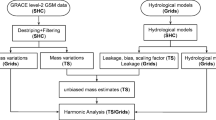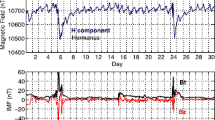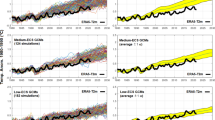Summary
The global nature of the Madden-Julian Oscillations (MJOs) have been investigated by applying a frequency filter to daily data for the summer monsoon months (June to September) during two contrasting years—1987, a deficient monsoon year and 1988, an excess monsoon year. Several meteorological parameters at five levels in the troposphere have been examined. Regions with large amplitude of these oscillations are isolated for each year. The results indicate that the global spatial distribution of these oscillations is more in a deficient year than in an excess year, in particular over the Indian subcontinent and the EI Niño Southern Oscillation (ENSO) regions. The principal modes of variability during these two years have been investigated through Empirical Orthogonal Functions (EOFs). The first two eigenmodes of 850 hPa zonal wind explain nearly 50% of the variance. The dipole type of structure between the Indian and the Pacific region is more apparent in 1987 than in 1988. Time-longitude cross sections of the filtered zonal wind over the equatorial regions clearly show that eastward propagation is detected in 1987, but is virtually absent in 1988. It is also seen that the 30–60 day filtered winds are stronger during the monsoon of 1987 than in 1988.
Similar content being viewed by others
References
Chowdhury, A., Sinha Ray, K. C., Mukhopadhyay, R. K., 1988: Intra-seasonal cloud variations over India during summer monsoon.Mausam,39, 359–366.
De, U. S., Chatterjee, S. N., Sinha Ray, K. C., 1988: Low frequency modes in summer monsoon circulation over India.Mausam,39, 167–178.
Kasture, S. V., Keshavamurthy, R. N., 1987: Some aspects of the 30–50 day oscillation.Proc. Indian Acad. Sci. (Earth Planet. Sci.),96, 49–58.
Kripalani, R. H., Singh, S. V., Arkin, P. A., 1991: Large-scale features of rainfall and OLR over India and adjoining regions.Contrib. Atmos. Phys.,64, 159–168.
Krishnamurti, T. N., Bedi, H. S., Subramaniam, M., 1989: The Summer Monsoon of 1987.J. Climate,2, 321–340.
Krishnamurti, T. N., Bedi, H. S., Subramaniam, M., 1990: The Summer Monsoon of 1988.Meteorol. Atmos. Phys.,42, 19–37.
Krishnamurti, T. N., Gadgil, S., 1985: On the structure of the 30 to 50 day mode over the globe during FGGE.Tellus,37A, 336–360.
Lau, K. M., Chan, P. H., 1986a: Aspects of the 40–50 day oscillation during the northern summer as inferred from outgoing longwave radiation.Mon. Wea. Rev.,114, 1354–1367.
Lau, K. M., Chan, P. H., 1986b: The 40–50 day oscillation and the El Niño/Southern Oscillation: A new perspective.Bull. Amer. Meteor. Soc. 67, 533–534.
Madden, R. A., Julian, P. R., 1971: Detection of a 40–50 day oscillation in the zonal wind in the tropical Pacific.J. Atmos. Sci.,28, 702–708.
Madden, R. A., Julian, P. R., 1972: Description of global scale circulation cells in the tropics with a 40–50 day period.J. Atmos. Sci. 29, 1109–1123.
Murakami, M., 1979: Large-scale aspects of deep convective activity over the GATE area.Mon. Wea. Rev.,107, 994–1013.
Murakami, T., Long-xun Chen, An Xie, 1986: Relationship among seasonal cycles, low-frequency oscillations and transient disturbances as revealed from Outgoing Longwave Radiation data.Mon. Wea. Rev.,114, 1456–1465.
Sikka, D. R., Gadgil, S., 1980: On the maximum cloud zone and the ITCZ over Indian longitudes during the southwest monsoon.Mon. Wea. Rev.,108, 1840–1853.
Singh, S. V., Kripalani, R. H., 1986: Application of Extended Empirical Orthogonal Function analysis to interrelationships and sequential evolution of monsoon fields.Mon. Wea. Rev.,114, 1683–1610.
Singh, S. V., Kripalani, R. H., 1990: Low frequency intraseasonal oscillations in Indian rainfall and outgoing longwave radiation.Mausam,41, 217–222.
Singh, S. V., Kripalani, R. H., Sikka, D. R., 1992: Interannual variability of the Madden-Julian oscillations in Indian summer monsoon rainfall.J. Climate,5, 973–978.
Yasunari, T., 1980: A quasi-stationary appearance of 30 to 40 day period in the cloudiness fluctuation during the summer monsoon over India.J. Meteor. Soc. Japan,58, 225–229.
Yasunari, T., 1981: Structure of an Indian summer monsoon system with around 40-day period.J. Meteor. Soc. Japan,59, 336–354.
Author information
Authors and Affiliations
Rights and permissions
About this article
Cite this article
Vernekar, A.D., Thapliyal, V., Kripalani, R.H. et al. Global structure of the Madden-Julian Oscillations during two recent contrasting summer monsoon seasons over India. Meteorl. Atmos. Phys. 52, 37–47 (1993). https://doi.org/10.1007/BF01025751
Received:
Revised:
Issue Date:
DOI: https://doi.org/10.1007/BF01025751




